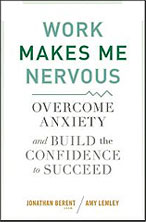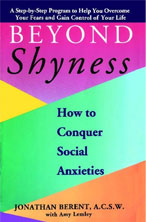Conversation Anxiety

View/Download Complete PDF of this Ebook
Problem solving
Enhanced social life
Enhanced academic performance
Willingness to ask questions Healthy self esteem.
The drawbacks of avoiding conversation may include having:
Defensive, overly vigilant attitude and behavior Underdeveloped social skills
Handicapped communication
Inhibited relationships
Technology overdependence
Handicapped social life
Limited career growth
Limited academic performance
Increased potential for an avoidant personality disorder Self-loathing
Depression
Chronic stress, which can to inappropriate use of substances
Avoidance
At its heart, conversation anxiety becomes about avoidance. Every time you back out of plans or make excuses or retreat into the shadows during a conversational opportunity, you are exhibiting the classic sign of an anxiety sufferer: Avoidance. If you are aware of avoidant behavior at work, you would be doing yourself a favor if you obtained Work Makes Me Nervous and completed the 21-day self-guided program. And if your conversation anxiety causes you to avoid social situations, I strongly urge you to obtain Beyond Shyness: How to Conquer Social Anxieties, which expands on the concepts we introduced you to in this e-book, enhancing your ability to conquer your fears; also available at your local bookstore or through online retailers such as www.BarnesandNoble.com and www.Amazon.com, Beyond Shyness not only addresses adults with social anxiety, but also offers insights especially for parents of children and teens with such issues. Both books feature my extensively tested strategies for overcoming anxiety and building confidence and skill.
Avoidance as a response to conversation anxiety can become selective mutism, which is so poorly understood that many sufferers go untreated, a fact that characterizes the treatment of social anxiety treatment in general.
Professionals remain confused about how to treat selective mutism. Elizabeth, age 12, was a straight-A student; yet she never raised her hand in class. If her teachers called on her, she would struggle to give a forced one-word answer. When she was with her peers at school or in social situations, she would not talk at all. Her parents enabled her by ordering for her in restaurants and filling in the silences when they socialized with other adults and families. She would never talk about feelings and would get aggravated when she was pressed. After eight sessions of therapy she was actually talking to me on the phone, but her obsessive worry and compulsion to not talk remained very extreme.
To help with her debilitating perfectionism, I suggested that her parents consult with physician to arrange for medication to treat her obsessive and compulsive characteristics. Their physician referred them to a psychiatrist who after one visit said to the parents, “She’s totally normal and she will talk when she’s ready.” Without treatment, however, I am pretty sure she will never be ready. This doctor’s professional ignorance may cost Elizabeth an entire life of conversation anxiety, debilitating stress, compromised relationships (or a lack of them), and career success. Sadly, I’ve worked with many individuals who are never “ready.” Check out some of the interviews at www.socialanxiety.com.
Another example of selective mutism and its costs is Brad. He had a lot of money in the bank from business deal. He was an expert in financial software programming. He was attractive and intelligent age 46. He had 2 children. He was recently divorced after 10 years of marriage. Other than his wife he had no other intimate relationships with women. His wife facilitated most, if not all, of the verbal communication between the two of them. After one year of separation he was a responsible and motivated father; lonely, somewhat depressed and dependent on his four or five beers a night for entertainment and mood control. He started dating through two on line services. He found that given his “profile” there was a lot of interest from the opposite sex as he was considered a “good catch”. After going on dates with 7 women there were no second dates. These women did not like the responsibility of having to carry 85 percent of the conversation; a dynamic that his wife used to do. To what extent do you avoid the types of conversations that give you the strongest gut reaction? How do you justify that to yourself? What does it cost you personally?
Using Logic and Objectivity
Let’s return for a second to that uh-oh question: “Is everything okay?” Try viewing the circumstances surrounding that question more objectively. If you answer with a perfunctory reply of “Fine, thanks,” “Can’t complain,” “Doing well. How about you?” or any of the other standard responses, you and your conversation partner can move on to other topics, continue down the hallway at work, or conclude your cashier transaction”whatever it is you are doing at the time. You might freeze in that moment, allowing your obsessive worry to take over: “What? Don’t I look fine?” “Can they tell I’m nervous?” “I want to tell the truth, but that would mean going on for 10 minutes about how ‘not fine’ I am right now.”
In that moment, you may choose to say nothing at all because you are so distracted by your obsessive fear. And that too often awkward silence”more than whatever friendly, mundane answer you might have given”can leave others without much of an impression of you either way or possibly even with the impression that you are odd, rude, snobbish, unfriendly, and so forth. Which I expect is the total opposite of the impression your perfectionist self was longing to make!
It’s a paradox: You want to avoid making a fool of yourself, essentially. So you make a fool of yourself. Yet it is an extremely hard habit to break, and if you continue to let it rule your day, it will likely get worse and it could even become a full-blown phobia.
When you get that “deer in the headlights” feeling as someone is about to ask you how you are, take a quick breath. Smile. Have an answer ready”a single word such as “fine” or “great” is all you need. If you like, you can add “How about you?” Try this. It is not as hard as it sounds, and it will get easier with ever attempt.
And finally, get it into your head once and for all that everybody makes mistakes. (Visit www.youtube.com and search on “TV bloopers” if you’d like to see some humorous proof!). Read it again: Everybody makes mistakes. The person you are talking with is focusing on his or her mistakes, not on yours. Cut yourself a break!
A Gut Reaction
Have you ever stopped to think about exactly what goes on when you notice a conversation”or even the thought of one”begins to make you anxious? For most people, it’s a visceral response”a “gut reaction” of physical discomfort followed by a thought. The physical feeling precedes the mental response. It is an automatic reflex that happens before you become conscious of it. Bringing the process to a conscious level is an important part of gaining control of your conversation anxiety response.
You are going to learn to reverse that one-two punch. How? By doing your thinking in advance of your gut reaction. I will show you how to mentally prepare yourself for any conversational situation you are about to enter.
An essential part of overcoming conversation anxiety is identifying and connecting your anxious thoughts and emotions with the physical (“visceral”) sensations you experience as you have those thoughts and emotions. And vice versa: When you experience physical sensations, you must learn to connect those sensations with your thoughts and emotions. As part of this ongoing “conversation with yourself,” you will learn to make this connection.
When you pay attention, your patterns will probably become obvious. A client named Kyle, a high-level media executive supervising 200 people, was responsible for leading a division-wide Q&A session almost every week.
This was a successful executive with a high six- figure salary; no one knew he suffered performance anxiety brought on by conversation anxiety. Five sessions into his therapeutic treatment, Kyle said something interesting: “For the first time, I was aware of the anxiety-related visceral sensations in detail. Before, I was never focusing on them. I was just focusing on how to get through the situation. Now, I can attach to those feelings in the moment.” That was the beginning of Kyle’s taking control because you have to consciously feel that which you want to control. Kyle achieved this with the use of his BioCard (more about the BioCard later…).
Kyle then surprised me by beginning to chuckle. “It’s amusing how consistent my pattern of cold hands is. I had no idea I was so predictable.”
But predictability in this case is a good thing. By recognizing your symptoms, you can connect with them in real time. Once you attach to them, you can learn to disarm them. Kyle said something else that I found striking. “For the first time,” he told me, “I feel like I can really do this. I can be proactive and think things through before that automatic physical reaction happens.”
Neural Pathways
Remember that your mind and body operate from the same headquarters: Your brain. The neural pathways within your brain are responsible for retrieving information from the brain and expressing it verbally. Retrieving information from the brain and e-mailing or texting, while


